Glendale Community College’s Nursing Program continues to grow, preparing students to meet the state’s healthcare demands through hands-on experience and mentorship. Interim Associate Dean Michelle Ann Ramirez explained in an interview that the program has become a vital part of the local healthcare community.
The program’s curriculum emphasizes the development of the knowledge, skills, and attitudes necessary to practice safely and effectively within the scope defined by the California Board of Registered Nursing (BRN). Upon successful completion of the program, graduates are eligible to apply for the state licensure exam.
According to Ramirez, the COVID-19 pandemic posed significant challenges. “We lost access to some clinical sites,” she explained. “There were too many patients and not enough staff, so we couldn’t take in as many students. I couldn’t enroll more students without enough hospitals for training.”
Ramirez has a vision to expand the program, not only for traditional RN students, but also through a bridge program for Licensed Vocational Nurses (LVNs) already working in the community. “They can take one year of our classes and become RNs. That is the program I want to grow. To do that, I must maintain strong relationships with our executive administration and community hospital partners. We rely heavily on these partnerships,” she added.
To maintain its competitive edge, the program continuously upholds high standards. With grant funding from the California Community College Chancellor’s Office, the department ensures that it adheres to best practices to improve healthcare outcomes. “GCC truly lives its mission,” Ramirez said. “We strive to treat students with respect and connect them with resources to help them become the best version of themselves.”
Every instructor in the nursing program is a registered nurse, and maintaining licensure requires 30 hours of continuing education every two years. Faculty members are encouraged to pursue ongoing professional development and Ramirez actively seeks funding to support this. “Their training benefits not just [faculty], but also the students who gain updated, real-world knowledge,” she said.
Ramirez shared an example of one faculty member passionate about virtual reality in nursing education. “I received a call from a specialist at a VR company, and we are exploring how this instructor can attend training and teach the rest of our team. This could lead to our students practicing in a simulated environment before entering a hospital.”
Student experiences reflect the intensity, hard work and reward of the program. “The first semester was the hardest,” said senior nursing student Danielle Kerr. “It was a huge transition from regular school. Everything was new, and we started hospital clinicals right away. I had to prioritize school and make time for friends and family on weekends to recharge.”
Another student, Carina Leyva, who is graduating next month, shared her lifelong dream of becoming a nurse: “Growing up with health challenges, I was deeply moved by the compassion of the nurses who cared for me when I was in the hospital. That inspired me to offer the same care to others.” She emphasized how tough the first semester was. “Med-Surg I was the most challenging. I struggled with the exams and doubted myself. But when I reached out to Ms.Ramirez, she connected me with a mentor who helped me through. Passing that class reminded me of my resilience.”
Leyva also highlighted the essential qualities of a great nurse: “Compassion, empathy, strong communication, attention to detail, resilience, time management, adaptability, and critical thinking.”
The program works closely with local hospitals to ensure students gain relevant clinical experience. Students build relationships with practicing nurses, train in labs, and engage in simulations, case studies, and video-based learning to prepare them for real-world scenarios.
Inclusion and diversity are key priorities for Ramirez as well. “I remind my staff to stay open-minded, ask questions, and understand each student. I try to model this behavior in how I treat anyone who comes to our department. We keep a student-centered lens by coaching and empowering to make all the difference.”
Program success is measured through key performance indicators: licensure exam pass rates, student retention, and job placement. The department follows all California BRN guidelines, and graduates must pass the state board exam. “Our goal is an exam pass rate of 90–95%. Last year, it was 96.55%,” Ramirez shared. “Retention is vital as students must finish within the promised two years. Around 90% or more of our students complete the program. Within six to eight months after graduation, 83% of students are employed as RNs. By a year or more, nearly all are working.”
Looking to the future, students have ambitious goals. Kerr hopes to work in a neuro step-down or ICU unit and eventually become a nurse practitioner. “In five years, I’d love to be pursuing my master’s degree,” she said.
Leyva envisions herself as “a confident and experienced nurse, possibly in pediatrics, mentoring new nurses, and pursuing advanced education or specialty certifications.”
Ramirez concluded, “We support our faculty and students by providing the tools they need. Many of our faculty are alumni who are passionate about giving back. That is how much we care. The program is already hard. But when we coach and empower students, it can make all the difference.”
Zhanna Kazazyan can be reached at [email protected].

